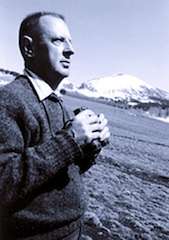Marshall Sprague
Marshall Sprague (March 14, 1909 – September 9, 1994) was an American journalist in New York, Paris, and China and author of books about western United States History. From Ohio, he moved to Colorado Springs, Colorado to recuperate following a diagnosis of tuberculosis and settled there. He received the Colorado Authors League Top Hand Award for Massacre: The Tragedy At White River and A Gallery of Dudes.
Marshall Sprague | |
|---|---|
 Marshall Sprague in April 1964 | |
| Born | March 14, 1909 |
| Died | September 9, 1994 (aged 85) |
| Nationality | American |
| Occupation | Journalist and writer |
Notable work |
|
Early life and career
Born March 14, 1909[1] in Newark, Ohio, he graduated from Lawrenceville School and Princeton University (1930), both in New Jersey.[2][3] After Princeton, he first worked at Women’s Wear Daily.[3] He was a journalist in Paris for the New York Herald-Tribune's Paris edition and China for North China Star . He then contributed to The New York Times, writing book reviews and articles for the Sunday Times.[2][3]
He moved to the North End of Colorado Springs, Colorado following a diagnosis of tuberculosis in 1941.[4][5] As he recovered, he wrote The Business of Getting Well.[5]
He is the author of Money Mountain (1953) about Cripple Creek and Victor gold mining. In 1957, he received the Colorado Authors League Top Hand Award for Massacre: The Tragedy At White River[3] of the Meeker Massacre of 1879.[5] He wrote Newport In The Rockies: The Life And Good Times Of Colorado Springs (1961),[4] which Cleveland Amory, a social historian, described as "candid, graceful, diligently researched". He also wrote A Gallery of Dudes (1967) described as a book of "wonderful tales about eminent commoners and titled Europeans awash in the exhilarating landscapes of America's last frontier" by a critic.[2] It received the Top Hand Award in 1967.[3] In 1976, his book Colorado, A Bicentennial History was published.[6] Another of his books of western history was So Vast So Beautiful a Land: Louisiana and the Purchase about the Louisiana Purchase. His memoir, Sometimes I'm Happy, was published the year following his death, with the assistance of family and friends.[7]
Personal life
Married February 1939,[8] his wife was Edna Jane (E.J.) (née Ailes) Sprague, an activist, serving civic commissions and boards and the Colorado Springs City Planning Commission.[2][4][lower-alpha 1] They had three children, Sharon, Stephen, and Joseph.[2] He was a jazz piano player and bird watcher.[3]
Sprague died in Colorado Springs at St. Francis Hospital at the age of 85 in September 9, 1994.[2][9]
Legacy
In 2014, Alex Johnson of The Gazette said of Sprague's influence:
Marshall Sprague Park in Colorado Springs is named for him.[11] Located at 3492 W. Woodmen in the Peregrine neighborhood, it was dedicated on August 7, 1999.[3]
Notes
- Born in West Virginia in 1911, Edna Jane attended Vassar. She died in late May 2006 in Albuquerque, New Mexico, after having lived in Colorado Springs for more than 60 years. She was the first woman to serve on the planning commission for the city and worked on historic preservation and establishing planning and zoning code. She sat on the city's park board, strongly supported the Colorado Springs Fine Arts Center over three decades, and helped established a multi-disciplinary approach and half-way house for treatment of injured people. E.J. starred in Colorado Springs Civic Players productions.[8]
References
- James P. Tate (June 1, 2002). The American Military on the Frontier. The Minerva Group, Inc. p. 188. ISBN 978-0-89875-997-6.
- "Marshall Sprague, Western Author, 85". New York Times. September 17, 2017.
- "Marshall Sprague Park". City of Colorado Springs. Retrieved May 12, 2017.
- Robert D. Loevy (March 1, 2010). "Ye Complete History of the Old North End Neighborhood in Colorado Springs, Colorado" (PDF). Colorado College. p. 11. Retrieved May 10, 2017.
- "Marshall Sprague Relates History of Meeker Massacre in New Book". Steamboat Pilot. May 23, 1957. Retrieved May 12, 2017 – via Colorado State Library.
- C. W. Buchholtz (1997). "Rocky Mountain National Park: A History". University Press of Colorado. Retrieved May 12, 2017 – via National Park Service.
- "Sometimes I'm Happy". Swallow Press. Retrieved May 12, 2017.
- Bobbi Sankey (June 6, 2006). "Woman left her mark on Springs". The Gazette. Archived from the original on November 19, 2018 – via HighBeam Research.
- "A Look Back: Images from Colorado Springs' past". The Gazette. Retrieved May 12, 2017.
- Alex Johnson (April 22, 2014). "GUEST COLUMN: City Needs an Academic Study of Its History". The Gazette. Colorado Springs, Colorado. Retrieved May 12, 2017 – via HighBeam Research.
- "Park controversy dissolves; a year later, Peregrine neighbors are pleased". The Gazette. July 19, 1999. p. 1.
Further reading
- Sprague, Marshall (1964). The Great Gates: The Story of the Rocky Mountain Passes. Boston: Little, Brown.CS1 maint: ref=harv (link)
- Sprague, Marshall (1994). The King of Cripple Creek: the Life and Times of Winfield Scott Stratton, First Millionaire from the Cripple Creek Gold Strike. Colorado Springs: Friends of the Pikes Peak Library District. ISBN 1-884003-04-4. OCLC 32174323.